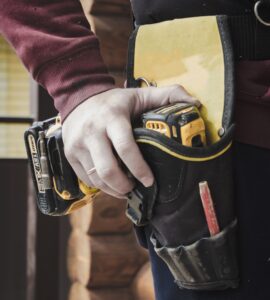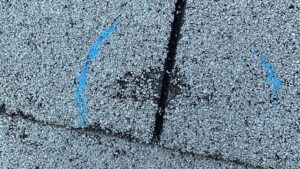If you are thinking about replacing a flat roof, you may wonder why you cannot use shingles on these surfaces. Asphalt shingles are the most common type of roofing material used today, but there are times when it is not a viable or beneficial option. That includes any low slope or flat roof.
Some people still use asphalt shingles on these roofs. There are several problems with that. First, it doesn’t offer the water protection the roof structure needs. Second, it typically violates any warranty protections from the manufacturer of those shingles. There are various good reasons for this.
Why Shouldn’t You Install Shingles on a Flat Roof?
A flat roof or low sloped roof is one in which the roof pitch (or the angle of the roof in comparison to the ground) is lower. You can calculate your roof’s pitch. To do so, calculate the number of feet or inches that the roof rises vertically for every 12 inches it extends horizontally. This creates a ratio. If that ratio is under 2:12, you have a low sloped roof and shouldn’t use shingles.
Asphalt shingle manufacturers may provide specific requirements for these roofs, such as what pitch ratio is acceptable. Some area building codes also restrict shingles from being used on low sloped.
The reason for this is that these roofs do not have enough of an angle to encourage water to run off of them. The shingles are not meant to allow for water to sit on them. Rather, the design of shingles encourages water to run down the shingles to the gutters.
That means that if you have asphalt shingles on a flat roof, the water is going to pool on the shingles. It does not have the necessary amount of gravity to pull the water off. The direct result of this is that water will sit on the shingles, and as it does, it shortens the lifespan of the material. Over time, it will lead to significant damage and leaks.
What Problems Occur with Flat Roofs When Shingled?
When shingles are installed properly on a surface, they lay on top of each other, creating a scaled look on the surface. The top portion of each shingle sits under the shingle above it. This creates a way for water to flow down off the shingle and into the gutter system below. This creates a very effective barrier against water.
Shingles work their best at a roof pitch ratio of 4:12 but should never be used on a roof with a 2:12 pitch or lower. That makes them no longer effective. Imagine that scaling process on a flat roof. Without the angle, the water sits on the shingle and even can get up into the shingles and into the underlayment on them.
Another problem is winter. During the winter months, the moisture on the surface of a roof will freeze and melt over and over again. If that moisture gets under the shingles on the roof and then freezes, the ice expands, causing bigger gaps between the shingles. As it melts, there’s more risk of the water penetrating into the roof surface. This creates a high risk for ice dams to form as well.
What If the Roofing Contractor Recommends This?
Most property owners don’t realize there is a risk to installing shingles on these surfaces. They simply go by what the roofing contractor recommends. If your contractor recommends this, it could be because they do not realize that some or all of the roof is a low slope, or they do not have proper training and experience. In either situation, it’s a disaster for you.
Even if it is recommended, remember that within a few months to a year or so, you’ll likely start to see leaks develop. If your roofing contractor isn’t going to warranty the shingles for long enough or their workmanship, that puts you at risk.
In short, if the contractor recommends shingles for any part of your roof that’s flat or low sloped – under that 2:12 ratio, consider finding another contractor. If they do not get this right, they may not get other steps right in laying your new roof as well.
What Type of Roofing Material is Available for Flat Roofs?
The good news is there are roofing materials that are just as attractive and highly functional as shingles are. That means you can easily use them instead of shingles. The costs may differ between products, but they can be affordable as well. Here are a few examples to consider.
- TPO: This type of roofing is made with a type of rubber. It’s white, which helps it reflect the sun. It can be used for residential and commercial applications.
- EPDM Rubber: This is a different type of rubber that comes from natural gas and oils. It’s highly durable, with a lifespan of more than 50 years.
- PVC membrane: This is an attractive type of roofing material that has two layers of PVC roof material with a polyester layer between them. It’s more flexible than other options and more water resistant.
- Modified bitumen: This type of roofing product is an asphalt product that is applied either with heat or cold. It’s highly durable and weather resistant but can be less attractive than other options.
- Spray on roofing materials: For those looking for a lower cost for a roof that may have some cracks in it, a spray-on solution may work well. It helps to get into uneven areas well.
Finding the Right Roofing Solution for You
Whether for your home or business, roofing materials are a key part of creating a safe and sound structure. When done well, you should not have to replace your roof or make repairs to it for a decade or longer, and depending on the type of roof, you may get 25 to 50 years of use out of it. Don’t turn to shingles that are ineffective and can create a much bigger problem for not just the roof but also the structural components of it underneath the surface.





